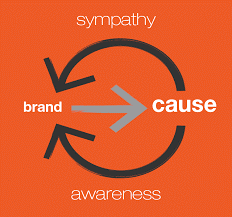Take a cursory look around the marketing environment and you will notice how brands are striving to align their brands to a social cause (health, education, environment etc).
Media proliferation and clutter, declining consumption of traditional media, and increased customer expectations are driving brands toward cause branding.
What is Cause Branding and how does it differ from Cause Marketing? This write-up will shed more light on what cause branding is, how it differs from cause marketing, and the reasons behind the incessant rise in cause branding by firms.
What is cause branding?
Cause branding is a strategy to unite a brand’s core value(s) with a consumer’s passion and the right cause partner to raise awareness and funds to positively impact a societal need. Cause branding has proven to be potent and effective strategy firms can implement to differentiate their brand and build emotional connections and relationships with core customers and target consumer segments.
Cause branding and cause marketing, any difference?
There appears to be a thin line between cause branding and cause marketing. Whereas some perceive the two to be one and the same, there actually exists a difference between the two.
Cause marketing is intended to have a positive influence on consumers by aligning with a cause and facilitating a consumer to support the cause through a short-term marketing promotion. Cause marketing is characterised by one-time support of causes with a traffic-driving or public relations objective. In the marketing world, the first cause marketing campaign is credited to American Express, when in the early 1980’s, the firm decided to donate a penny out of every purchase made toward the restoration of the iconic Statue of Liberty. The campaign connected a brand (American Express) to a cause (Statue of Liberty restoration), facilitating consumers to make financial contributions by doing business with the brand.
Cause branding, on the other hand, is a continuous association of a brand with a cause via internal and external programmes. Secondly, unlike cause marketing that can be done for several initiatives or projects, cause branding tends to focus on a single cause. The ONE4Life initiative by Awake Mineral Water – where for each bottled water sold, 50 pesewas is donated to the National Cardiothoracic Centre – is an example. This initiative is a continuous campaign. Other examples include Rotary International’s Kick Polio Out campaign, TOM’s One-for-One campaign – where they promise to deliver a pair of free, new shoes to a child in need for every sale they make.

Benefits of cause branding.
The growing appetite for cause branding among firms is ample testimony of the enormous benefits cause branding offers.
Cause branding enhances a firm’s brand’s image. Studies conducted by Cones Inc. in 2007 showed that 83 percent of respondents admitted they have a more positive image and credibility of a brand that supports a cause they care about. Secondly, cause branding augments the brand’s perceived performance. Cause branding also encourages customers switching from one brand to another. A recent study showed 87 percent of respondents being likely to switch from one brand to another – price and equality being about equal – if the other brand is associated with a good cause. Cause branding also serves as a source of differentiation, leadership and competitive advantage for brand. It also deepens a brand’s relationship with its customers and lastly help brands stand out in an increasingly crowded marketplace.
Drawbacks of cause branding: Despite the plethora of benefits that cause branding offers to firms and brands, it is not without some drawbacks. As noted by Alexander Chernev in his book, Strategic Brand Management, cause branding can result in brand dilution. When a brand is associated with a myriad-unrelated social causes, it has the tendency to obscure the core values and positioning of the brand. This brand dilution effect becomes more pronounced when several brands are all championing the same social cause, making the brands seem similar to one another. Secondly, cause branding can let consumers have compensatory inferences, making consumers have a lower perception about the brand’s functional performance. Lastly, negative information spillover is another drawback of cause branding in the unlikely event of a scandal rocking the endorsed social cause. A case in point is when a doping scandal rocked Lance Armstrong – a cancer survivor and professional cyclist –the founder and spokesperson of the LiveStrong Foundation, an NGO providing support for cancer patients.
How can brands initiate cause branding?
Brand nowadays are exploiting avenues through which they can incorporate cause branding in their marketing communications and public relations campaigns to derive the benefits it offers. To do this, brands must implement the following:
- Conduct a key-issues analysis: To start with, brands must conduct extensive research to identify the issues that are relevant and resonate with their target audience and at the same time align with the brand .Through competitor analysis, expert’s interviews/ opinions and sentimental analysis, brands can identify issues and social causes worth aligning themselves with.
- Select the right cause: The outcome of a key-issues analysis will bring to fore options from which the brand can select from. It is imperative that brands select a cause that aligns with their culture, values and/or its products and services. Secondly, cause must be relevant to a brand’s core customer segment. Example is a mining company choosing a cause like land reclamation programme.
- Forge strategic partnerships: The last hurdle for firms to overcome when incorporating cause branding in their operations is the formation of strategic partnerships. A healthy partner should be one that is credible, have capacity to execute activities, and possess sound financial clout.
Conclusion:
Cause branding can be said to be the growth stage, and it has been touted as the single most effective strategy brands can employ to establish emotional relationships with target consumers. It is, therefore, essential for brands to identify a cause and stand for that, before consumers perceive the brand as standing for no cause.
About the writer: Godfrey is a Chartered Marketer and National Business Manager of Mega Lifesciences Ghana Ltd. He also lectures at Ghana School of Marketing and Simon College of Marketing. Godfrey undertakes Corporate Trainings and can be contacted through [email protected], 0205220830.










